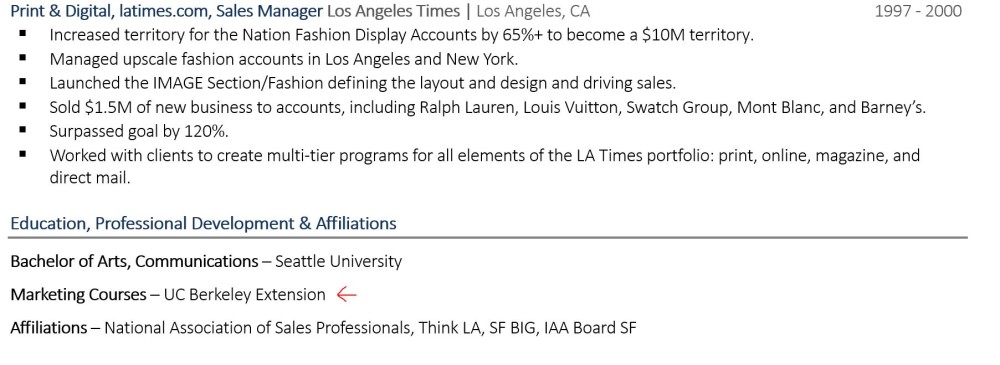How to Format Continuing Education on Resume
An average of 250 resumes are sent for a corporate job opening which is why you really need to stand out from the competition. Showing professional development on a resume like continuing education is always a plus. Professional development is a great way to earn a promotion or even get a raise. We'll show you where and how to include continuing education on your resume.
What is continuing education?
Continuing education is a program, training, or additional courses which one may need to take in order to maintain his or her license in their profession.
Many fields require continuing education courses or professional development opportunities. This helps professionals touch up on their knowledge and stay up to date on the newest developments and subject matter expertise in their industry. This can include things like new regulations, systems, and other changes within the industry.
Some industries that may require continuing education are:
-
Teachers
-
Insurance professionals
-
Interior designers
-
Interior architects
-
Lighting designers
-
Architects
-
Engineers
-
Emergency management professionals
-
School administrators
-
Educators
-
Nurses
-
Mental health professionals
-
Psychologists
-
Social workers
-
Project management
-
Professional writers
Continuing education is typically measured in units - Continuing education unit (CEU) or continuing education credits (CEC). They can be taught at colleges or government employment offices.
How to include continuing education on a resume
You would usually list professional development and continuing education under "Education" or the "Professional Development" section. This section would typically be the last section on your resume.
You can also use a different title or a combination like "Education and Professional Development".
Listing continuing education on your resume is simple! Here is how it's done:
Step #1
Decide exactly which continuing education and professional training you want to include on your resume. Anything you list should be relevant to the position you're applying for.
For example: Taking online courses in marketing would not be included on your resume if you were applying for an accounting position. Listing irrelevant information on your resume will annoy a hiring manager or recruiter.
Step #2
List your continuing education and any other relevant information.
List the courses taken, name of the program, and other relevant information. If you completed the course, you can also list the year.
Example of continuing education on a resume:
Education, Professional Development & Affiliations
Bachelor of Arts, Communications – Seattle University
Marketing Courses – UC Berkeley Extension
Affiliations – National Association of Sales Professionals, Think LA, SF BIG, IAA Board SF

How continuing education on a resume helps with career advancement
While continuing education is required for many industries - Some continuing education is voluntary and could help give you a leg up on other candidates when applying for a job.
Continuing education can even include online courses on your resume. Just make sure it's relevant to whatever position you're applying for before listing it on your resume.
It can also allow you to get promoted faster or even a fatter salary. Professional development of any kind will help you progress in your career. Employers love to see a candidate who is committed to learning and progressing within their industry or role.
Quick tips for continuing education on a resume
-
List the most important items first. This is what the employer will see first so be sure that the most important items are listed first.
-
Include the year only if you completed continuing education you're listing within the last 5 years - otherwise don't include the date.
-
We mentioned this before and we'll mention it again: don't list irrelevant information on your resume. This includes continuing education that has nothing to do with your industry/position.
Summary
Many industries require continuing education for educational and workforce needs but you can also choose to further your education on your own. Including professional development opportunities like continuing education can really help you stand out from the pool of candidates.
It can also help speed your career progression and land you a bigger salary.
Related posts:
-
Writing Your Education Section: Samples & How to Guide
-
7 Free Certifications To Enhance Your Resume
-
10 Best Skills to Put on Your Resume
This post was written in 2018 and has been updated to reflect our current style guidelines and more up-to-date career advice.
Source: https://www.zipjob.com/blog/continuing-education-on-a-resume/
Postar um comentário for "How to Format Continuing Education on Resume"